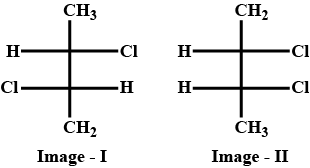
Answer
440.7k+ views
Hint: The above molecules are meso isomers of each other. Meso forms are optically inactive that means they show no rotation.
Complete step by step solution:
Optical isomers have the same physical and chemical properties but they differ in their behaviour towards plane polarized light. An optically active compound is the one which can rotate plane polarized light. Those which can rotate PPL (plane polarized light) towards right are known as dextrorotatory compounds (d form) and those which can rotate PPL towards left are known as laevorotatory (l form). The angles by which dextrorotatory compounds rotate PPL towards right are represented with + sign. On the other hand angle by which laevorotatory compounds rotate PPL towards left are represented by – sign. The compounds which fail to rotate PPL are known as optically inactive. Optically active compounds have dissymmetry, chirality and are non super imposable mirror images of each other. For example: 2-Hydroxypropanal Propanoic Acid or lactic acid is an optically active compound.
Stereoisomers which are mirror images of each other are known as enantiomers. Diastereomers are stereoisomers which are not mirror images of each other. Meso compounds are those compounds which have chiral carbon but still they are optically inactive due to internal compensation. Racemic mixture is the one which has equal concentration of d & l form compounds and also racemic mixture are optically inactive.
According to the question, as we can see in image 1 the given compound have chirality and dissymmetry (have no centre of symmetry and no plane of symmetry) it is optically active and as given its optical rotation is \[ + 36^\circ \] which means it is the d form or Dextrorotatory. The compound given in image 2 is its meso form. The meso form is optically inactive.
Thus, the correct answer is zero optical rotation.
Note:
The prediction of optical behaviour of a compound is only done by experimental explanations. Compounds with only 1 chiral carbon are always optically active.
Complete step by step solution:
Optical isomers have the same physical and chemical properties but they differ in their behaviour towards plane polarized light. An optically active compound is the one which can rotate plane polarized light. Those which can rotate PPL (plane polarized light) towards right are known as dextrorotatory compounds (d form) and those which can rotate PPL towards left are known as laevorotatory (l form). The angles by which dextrorotatory compounds rotate PPL towards right are represented with + sign. On the other hand angle by which laevorotatory compounds rotate PPL towards left are represented by – sign. The compounds which fail to rotate PPL are known as optically inactive. Optically active compounds have dissymmetry, chirality and are non super imposable mirror images of each other. For example: 2-Hydroxypropanal Propanoic Acid or lactic acid is an optically active compound.
Stereoisomers which are mirror images of each other are known as enantiomers. Diastereomers are stereoisomers which are not mirror images of each other. Meso compounds are those compounds which have chiral carbon but still they are optically inactive due to internal compensation. Racemic mixture is the one which has equal concentration of d & l form compounds and also racemic mixture are optically inactive.
According to the question, as we can see in image 1 the given compound have chirality and dissymmetry (have no centre of symmetry and no plane of symmetry) it is optically active and as given its optical rotation is \[ + 36^\circ \] which means it is the d form or Dextrorotatory. The compound given in image 2 is its meso form. The meso form is optically inactive.
Thus, the correct answer is zero optical rotation.
Note:
The prediction of optical behaviour of a compound is only done by experimental explanations. Compounds with only 1 chiral carbon are always optically active.
Recently Updated Pages
Who among the following was the religious guru of class 7 social science CBSE

what is the correct chronological order of the following class 10 social science CBSE

Which of the following was not the actual cause for class 10 social science CBSE

Which of the following statements is not correct A class 10 social science CBSE

Which of the following leaders was not present in the class 10 social science CBSE

Garampani Sanctuary is located at A Diphu Assam B Gangtok class 10 social science CBSE

Trending doubts
A rainbow has circular shape because A The earth is class 11 physics CBSE

Which are the Top 10 Largest Countries of the World?

Fill the blanks with the suitable prepositions 1 The class 9 english CBSE

How do you graph the function fx 4x class 9 maths CBSE

What is BLO What is the full form of BLO class 8 social science CBSE

The Equation xxx + 2 is Satisfied when x is Equal to Class 10 Maths

Give 10 examples for herbs , shrubs , climbers , creepers

Difference between Prokaryotic cell and Eukaryotic class 11 biology CBSE

Change the following sentences into negative and interrogative class 10 english CBSE





